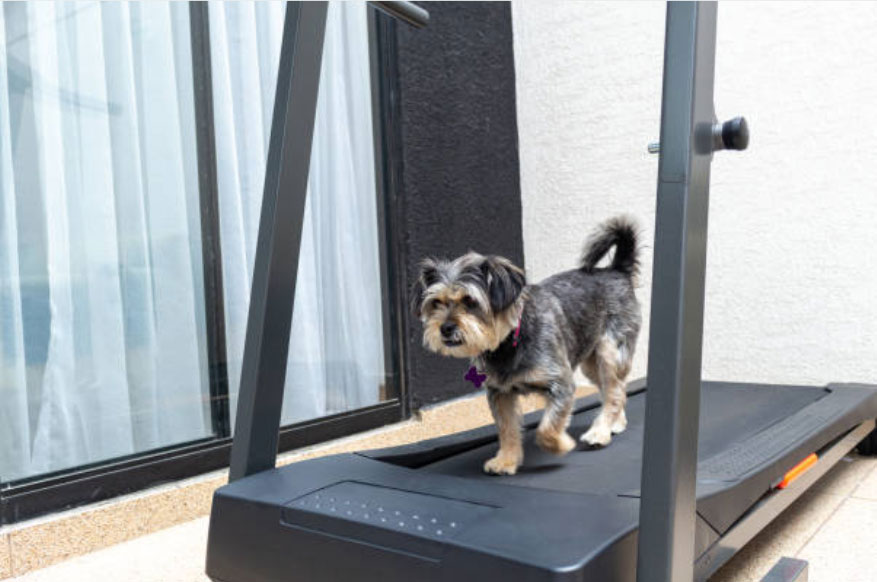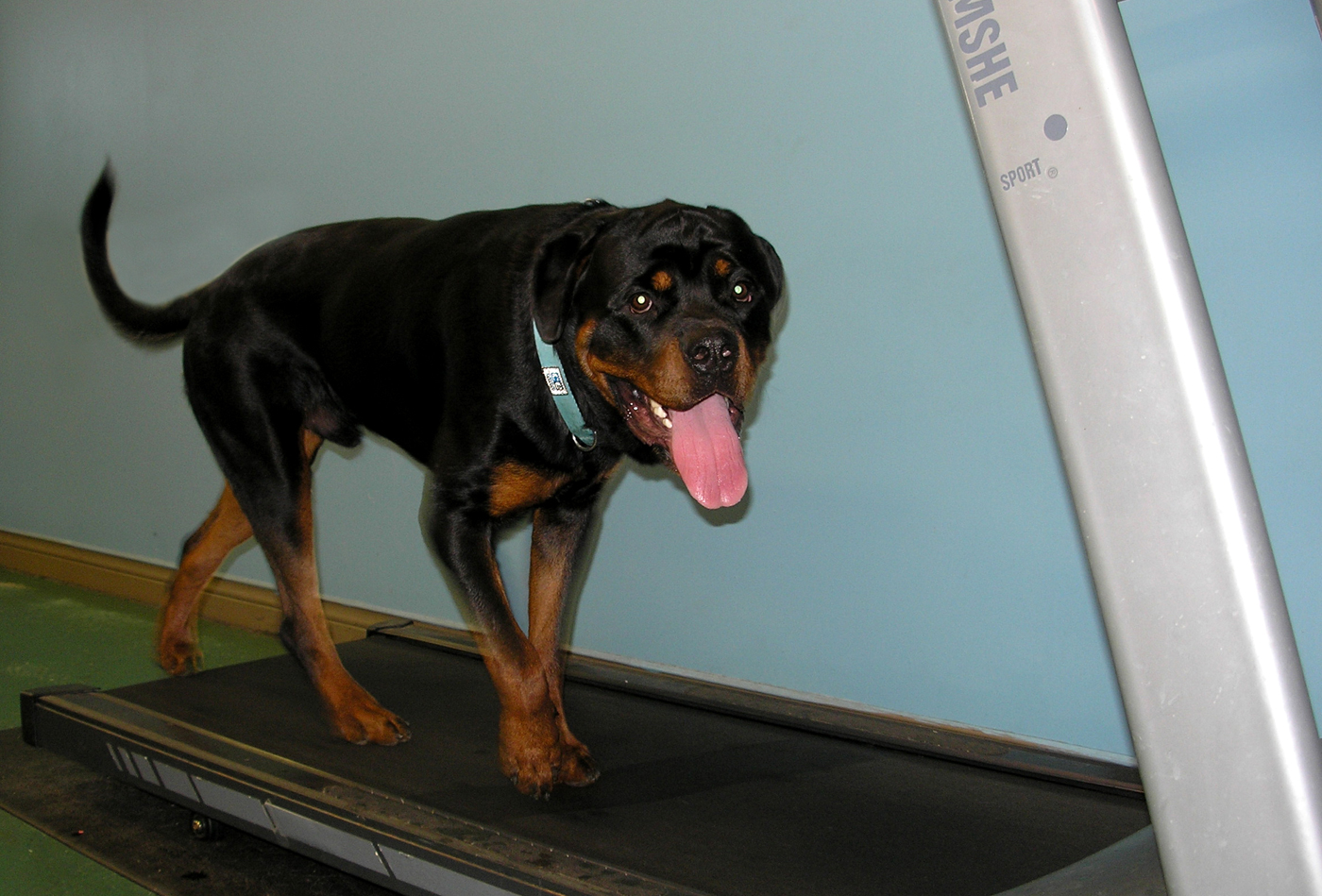Treadmill for dogs
Treadmills or treadmills for dogs are accessories that are most often found at veterinarians. Used in therapy, they allow the dog to regain its mobility after a physical trauma or to build up its muscles properly, for example to make up for weak ligaments.
For sporting dogs, it is also a must-have, as this accessory allows the animal to train very regularly to work on its endurance. To be beneficial to your dog, however, the treadmill must be carefully adapted to your four-legged friend and used wisely.
What is the purpose of a dog treadmill?
A dog treadmill can be used for a variety of purposes depending on the goal. It can be a therapeutic tool, a training aid or an accessory designed to promote the well-being and balance of your companion.
The treadmill for dog rehabilitation
The rehabilitation of a dog can be done through different procedures targeting a particular function of the animal. Massages, hydrotherapy, electroshock therapy or physiotherapy are all means used to re-educate a dog's body and help it regain its functions more quickly.
The treadmill is used to re-educate the dog's motor skills after the animal has been completely or partially immobilized for a long time. Re-education exercises are also recommended for preventive purposes, for example to build up muscles or to make a dog lose weight before a surgical operation.
In the case of functional rehabilitation after a problem (fracture, sprain, osteoarthritis, etc.), the treadmill will help the dog to relearn to move correctly or to learn to move differently. In the second case, it is often a case of a dog having permanently lost a motor function, such as the use of one or more legs, and having to learn to move on three limbs or with the help of a rolling cart.
In addition to skeletal and joint damage, the treadmill can be used to rehabilitate motor functions lost due to neurological damage. A dog that has survived distemper, heat stroke, violent epileptic seizures or head trauma may have nerve damage.
In this case, the patient must relearn how to correctly mobilize a specific part of his body or his body as a whole, depending on the brain damage he is suffering from.

The treadmill for the sports training of the dog
Great athletes need to train constantly to stay in shape, and some owners have to be content with working their dogs at home instead of taking them out for long periods of time. This can happen when the weather outside is too cold or rainy and the dog is particularly sensitive to the elements or, conversely, when it is very hot.
Dogs are very sensitive to heat stroke, and it is important to avoid strenuous activity when the temperature rises too high. A treadmill in an air-conditioned room can allow canine athletes to continue training even in the heat.
Some owners may not be able to take their dogs out as much as they used to, for example, if they are chronically or long-term ill, or if there are major changes in the household. A death, a separation or the birth of a child can disrupt the family's schedule, and the owner may have less time to train the dog.
For an athlete, a sudden reduction in sporting activity can cause significant stress, and a dog that no longer trains will also quickly lose its physical condition. The treadmill is therefore a beneficial accessory, both to keep the dog exercising and to keep him at the same level if he is destined to compete in the months to come.
Treadmills for the well-being of dogs
Lack of physical activity is a factor in almost all problematic dog behavior. Uncleanliness, destruction of the owner's property, constant barking, pushing and shoving or aggressiveness... Whatever its negative attitudes, a dog with deviant behavior is almost always in psychological pain.
In most cases, his unhappiness is due to a lack of availability of the owner to walk him or to needs of sport activity and attention involuntarily minimized. Indeed, few owners are aware that all dogs have a great need for sports activity, including Chihuahuas, Bichons or Yorkshires.
Smaller dogs, which are more sedentary, are often subject to aggressive and destructive behaviors that owners wrongly associate with a bad temper. And for good reason, they are the ones whose great need for activity is most often neglected, assuming that their little legs are not capable of swallowing miles, which could not be further from the truth.
For owners who have chosen a dog that is more tolerant of a sedentary lifestyle because they do not have the opportunity to take it out regularly, the treadmill is a solution to consider both to maintain your dog's physical condition and to prevent or cure behavioral problems. For all other dogs, the treadmill remains an accessory that allows them to maintain their physical health while keeping them busy, thus fighting against boredom, their nemesis.
Boredom, which goes hand in hand with a lack of physical activity, is also a great source of anxiety, resulting in deviant behavior in dogs.

How do I use a dog treadmill?
A misused treadmill can do a lot of harm to your dog, so it's important to use it with care. If you are considering purchasing a treadmill to rehabilitate your dog after an injury or illness, you must have your veterinarian's approval so that you don't risk making your dog worse and even undoing all the progress you've made so far.
Discuss this option with your veterinarian, who, depending on the situation, can prescribe specific exercises to be performed, as well as their duration and occurrence, to allow your dog to recover slowly. If you're considering a treadmill to train a sporting dog or to improve your dog's well-being, there are some safety guidelines to follow.
First, never leave your dog alone on a treadmill, even if he is used to using it. You must be present to ensure that no accidents occur, but also to make sure your dog doesn't get exhausted.
Dogs are not always tough, and it is crucial to offer your dog progressive efforts and not a sudden intense activity when he is not used to it. Be patient, and take as much time as you need for your dog's physical abilities to develop week after week and month after month.
By trying to go too fast, you risk injuring your four-legged friend instead of giving him a fun and healthy activity. Also remember to introduce your dog to the machine before you put him on it: many dogs are afraid of the treadmill when they have never used it before.
Don't rush your dog and let him sniff the treadmill and get used to it at his own pace by leaving it turned off. When your dog is no longer afraid of it, turn on the treadmill when your dog is not on it so that he can become familiar with the noise.
When your dog is no longer afraid of the noise or the strange machine, naturally invite him to get on it, secure him by holding his harness, and then try to start the Treadmill on the lowest speed.
Where to buy a dog treadmill and how much does it cost?
It is difficult to know where to buy a treadmill for dogs, because these products are still largely reserved for professionals and are therefore not available in pet shops, and even less in supermarkets.
However, you can find amateur treadmills for dogs on some online stores, which are suitable for small dogs and have good feedback from owners.
For professional treadmills, you should ask your veterinarian which distributor to turn to, noting that professional machines can be very expensive depending on their features.
Buying a dog treadmill is usually a good investment, which may hurt your wallet at the time, but it can help you avoid large veterinary bills in the long run by keeping your dog healthy.
In order to keep this accessory from costing you even more than its purchase price, it should be used with care so that it doesn't damage your dog's health, which would likely result in you having to resell it to pay for your dog's medical bills.


